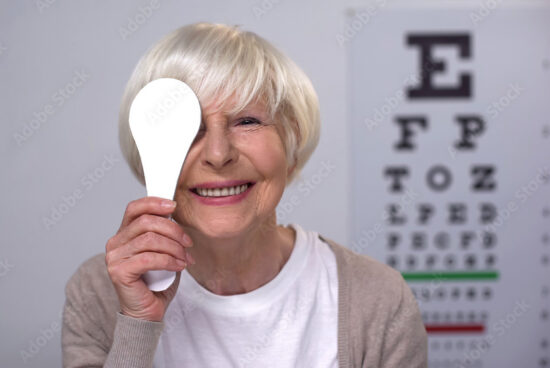July is UV Safety Month - click here for FREE healthy vision tips
Menu

In this article, we will discuss cataracts, a common eye condition that affects the quality of life for millions of people worldwide and is a leading cause of preventable vision loss. We will explore the causes, symptoms, potential treatments, and lifestyle modifications that can help reduce your risk of visual impairment. We hope you find this information helpful and encouraging!
Cataract formation happens when proteins in the eye’s lens bunch up and create a cloudy effect, making it difficult for light to pass through properly. It leads to blurry vision and can eventually cause significant loss of vision. Cataracts are a common eye condition typically accompany aging, but eye injury and specific diseases such as diabetes may also contribute to the risk factors for their development.
In the early stages, tweaking your eyeglass prescription, using brighter lighting, or trying out magnifying lenses could help you see better. But if cataracts progress, eye surgery might be recommended as part of a treatment plan. During cataract surgery, that cloudy lens is removed and replaced with a clear artificial one.
However, cataract surgery is not for everyone. While generally safe and effective, there are certain risks of cataract surgery. People with eye conditions like glaucoma or macular degeneration, or a medical history of health problems such as diabetes or high blood pressure, may have an increased risk of complications.
In addition, some people may also experience a secondary cataract, which can develop months or years after the initial surgery. Therefore, the decision to undergo cataract surgery should be made in consultation with a healthcare professional, taking into account the individual’s overall health, lifestyle, and personal preferences.
If you’re dealing with the early stages of cataracts, there is a safe non-surgical option you might want to check out: Can-C eye drops. These doctor-formulated drops contain a powerful antioxidant called N-acetylcarnosine, which is known to naturally rejuvenate and protect your eyes. Clinical studies suggest that Can-C eye drops might be able to slow down or even reverse the progression of cataracts.
The active ingredient in Can-C eye drops, N-acetylcarnosine, helps protect the eye’s natural lens by preventing cross-linking of proteins, the root cause of cataract development. By shielding the lens from oxidative stress and reducing existing cross-linked proteins, these drops aim to improve vision and slow down the progression of cataracts.
While Can-C eye drops cannot replace the need for surgery in advanced cataract cases, they offer a hopeful option for individuals with early cataracts. It is advised to consult your eye care professional before starting any new eye treatment or supplement.
Combine Can-C eye drops with Nac-C Plus capsules to enhance their effectiveness! Nac-C Plus was developed by a doctor to help boost the performance of Can-C eye drops in combating cataracts. When taken consistently with the eye drops, Nac-C Plus increases the time Can-C remains active in the eye while also reducing the oxidative environment within the eye, which allows for a faster healing response.
Can-C eye drops alone are already highly effective, but adding Nac-C Plus to the mix can optimize your efforts even further! This combination has a success rate and has been particularly helpful for those with more mature cataracts and noticeably diminishing vision. In a separate pilot study, researchers found that ripe human age-related cataracts were significantly reversed when Can-C eye drops and Nac-C Plus were used together for five months .
Cataracts, a common eye condition resulting from protein clumps in the eye’s lens, are a leading cause of preventable vision loss. Symptoms include blurred vision, sensitivity to light, and poor night vision. Cataracts are associated with aging but can also develop due to eye injuries or diseases like diabetes.
Over 24 million Americans aged 40 and older are affected by cataracts, accounting for 51% of global blindness cases. Risk factors include aging, health conditions such as diabetes, tobacco and alcohol use, prolonged sun exposure, and family history. Adopting a healthy lifestyle, managing medical conditions, quitting smoking, and wearing sunglasses with UVA and UVB protection can help reduce the risk of developing cataracts.
For early-stage cataracts, Can-C Eye Drops may be a potential option. Containing N-acetylcarnosine, these drops help protect the lens from oxidative stress and slow down cataract progression. It’s essential to schedule annual eye exams and consult an eye care professional to discuss any vision impairment in maintaining your eye health.
Understanding cataracts and staying informed about potential treatments, such as Can-C eye drops, is essential for maintaining your vision and eye health. Remember to prioritize annual eye exams, discuss any vision impairment with your eye care professional, and make necessary lifestyle modifications to reduce your risk. Invest in the health of your eyes today for a brighter tomorrow.
Free shipping on all US orders
Your data is safe
Satisfaction guaranteed
Email support is always available

*Disclaimer: The above statements have not been evaluated by the FDA. They are not intended to diagnose, treat, cure or prevent any disease or condition.
If you have a health condition or concern, consult a physician or your alternative health care provider.
Always consult a medical doctor before modifying your diet, using any new product, drug, supplement, or doing new exercises.
Use of this site constitutes acceptance of our Shipping and Returns Policy, our Terms and Conditions and our Privacy & Cookies Policy
| Cookie | Duration | Description |
|---|---|---|
| cookielawinfo-checkbox-analytics | 11 months | This cookie is set by GDPR Cookie Consent plugin. The cookie is used to store the user consent for the cookies in the category "Analytics". |
| cookielawinfo-checkbox-functional | 11 months | The cookie is set by GDPR cookie consent to record the user consent for the cookies in the category "Functional". |
| cookielawinfo-checkbox-necessary | 11 months | This cookie is set by GDPR Cookie Consent plugin. The cookies is used to store the user consent for the cookies in the category "Necessary". |
| cookielawinfo-checkbox-others | 11 months | This cookie is set by GDPR Cookie Consent plugin. The cookie is used to store the user consent for the cookies in the category "Other. |
| cookielawinfo-checkbox-performance | 11 months | This cookie is set by GDPR Cookie Consent plugin. The cookie is used to store the user consent for the cookies in the category "Performance". |
| viewed_cookie_policy | 11 months | The cookie is set by the GDPR Cookie Consent plugin and is used to store whether or not user has consented to the use of cookies. It does not store any personal data. |
Any questions? We’re here to help.